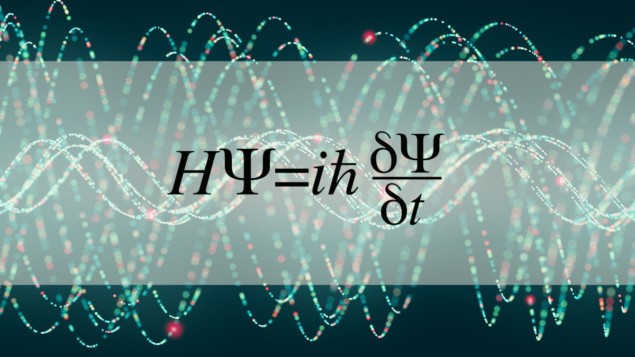
Complex numbers are essential to achieve the most accurate quantum-mechanical description of nature, according to experiments done by two independent teams of physicists. Both studies were inspired by the Bell’s inequality test of quantum theory and suggest that complex numbers are more than just a mathematical convenience when it comes to the formulation of quantum mechanics.
A complex number comprises a real number plus an imaginary number, which is a multiple of the square root of -1. While the mathematics of complex numbers underlies modern quantum theory, it is also possible to describe the quantum world purely in terms of real numbers. As a result, it had not been clear whether complex numbers play a crucial role in quantum theory, or if they are simply a useful tool.
Until recently, this had been a philosophical debate, but now two independent teams of physicists have devised two separate experiments to test the importance of complex numbers for quantum theory. One team was led by researchers at the Institute for Quantum Optics and Quantum Information (IQOQI) in Vienna, Austria and the Southern University of Science and Technology in China; and the other team by scientists at the University of Science and Technology of China (USTC).
Quantum operations
Each experiment implemented a series of quantum-information operations, manipulating light or a superconducting quantum bit (qubit). In both cases the outcomes of these operations were shown to be impossible to predict accurately by real-number quantum theory.
Miguel Navascués at IQOQI and a co-author of a paper describing one the experiments and the theoretical work that inspired it, draws an analogy between his team’s efforts and the way Bell inequalities, introduced by CERN’s John Bell in 1964, had been used to establish the necessity of quantum physics itself. In a Bell test, scientists can conduct an experiment, calculate a number based on its outcomes and use a Bell inequality to determine whether classical or quantum theory provided the best model of the experiment. Quantum theory always won, and Bell’s work has since had a profound influence on the burgeoning field of quantum information.
“No matter how clever you are or what complicated classical models you come up with, they can’t accommodate the results of these experiments,” Navascués explains. He and collaborators set out to do the same for real-number quantum theory. “If you can conduct this experiment, then you will have refuted real-number quantum physics,” he emphasizes.
A more correct description
USTC’s Chao-Yang Lu, who is a co-author of a paper describing the other experiment adds, “[Our work] uses an inequality to quantitatively distinguish two alternative theories”. As with Bell inequality experiments, he adds, their study clearly pinpoints the theory that is a more correct description of nature.
Paul Kwiat at the University of Illinois Urbana-Champaign, who is not a member of either team says, “I like that these experiments help clarify exactly how much of the [complex] quantum theory is necessary”. He adds, “It’s interesting to try and ask when we require complex numbers, because complex numbers themselves are kind of a weird thing.”
Both experiments started with a so-called “Bell game”. It included two “players” and a “referee”. Neither of the three was an actual person, but instead they were part of a complex measurement protocol. One player, Lu explains, is on “team complex quantum physics” while the other plays for “team real-valued quantum theory”.
“Black box” players
The theory that they play for determines the measurements they perform on qubits. “The players are sort of in a ‘black box’ and only make measurements on qubits that are sent to them,” Lu says. The referee calculates each player’s score based on the outcomes of their measurements, following specific mathematical rules originally proposed by Navascués and colleagues. “These scoring rules are designed to reveal differences between the two players,” emphasizes Lu.
In the USTC experiment, the Bell game took place in a superconducting quantum computer. It was played with qubits made of quantum states defined by the presence or absence of electric charge and the qubits were controlled by microwave pulses. The experiment done by Navascués and colleagues used a state-of-the-art photonic system instead. Here, players were encoded into a series of beam-splitters and waveplates that altered quantum information carried by photons, which are quantized bits of light.
Scores of both the photonic and the superconducting Bell game showed the complex quantum players “win” very dramatically. Indeed, the difference between real and complex players’ performance could get as high as 43 standard deviations.
Beyond mathematical hair-splitting
Implications of these Bell game experiments may go beyond heady philosophical questions about physical reality. Matthew Pusey at the UK’s University of York who was also not involved with the two studies explains that pitting real and complex quantum theory against each other goes beyond mathematical hair-splitting. Indeed, it could have concrete consequences for the field of quantum information, for instance in quantum key distribution – which is a cryptographic technique. “It’s surprising how much of what’s interesting about quantum theory from a quantum information point of view can be reproduced with real numbers,” he adds.

The conundrum at the heart of quantum physics – and how philosophers of science can help
Navascués further underlines that the new work points to there being real advantages to developing protocols for quantum networks based on complex-valued, instead of real-valued, quantum theory.
Having shown that complex and real quantum physics can be definitively distinguished in light-based and superconductor-based settings, the researchers are now exploring more precise experiments in both systems. Lu and his colleagues, for example, are already working on a stricter test of real-valued quantum physics. In this case the qubits used in the Bell game are separated by a few hundred metres to rule out some potential loopholes. He hopes these experiments will further inspire physicists to examine questions such as the meaning of complex numbers – and to do so through experiments. He says, “We used to ‘shut up and calculate’, but now is a good time to rethink many foundational problems in quantum mechanics and test them with quantum computers”.



